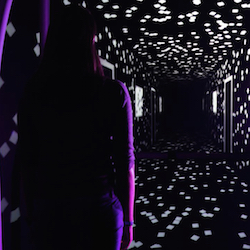
Virtual reality one day might be used widely to help train older adults to improve their balance while walking and help healthcare professionals diagnose balance impairments to prevent falls, suggests a new study published in Scientific Reports.
Study subjects walked on a treadmill in front of a large, curved screen depicting a moving hallway in the UNC/NC State Joint Department of Biomedical Engineering.
“As each person walked, we added lateral oscillations to the video imagery, so that the visual environment made them feel as if they were swaying back and forth, or falling,” said Assistant Professor Jason R. Franz, Ph.D., who led the research team. “The participants know they aren’t really swaying, but their brains and muscles automatically try to correct their balance anyway.”
Through 14 cameras recording the positions of 30 reflecting markers on the legs, back and pelvis of each subject, the researchers saw in detail how specific muscle groups that control postural sway and foot placement worked to correct a perceived loss of balance.
“These findings give us important insights into the detailed mechanisms of walking balance control,” Franz said.
The data also provided reference measurements that could be used in clinical procedures in the future to detect balance impairments before they cause people to fall.
“We think there’s a big opportunity to use visual perturbations in a VR setting to reveal balance impairments that would not be detected in conventional testing or normal walking,” he said. “The key is to challenge balance during walking, to tease out those impairments that exist under the surface.”
Franz and colleagues also are examining the potential use of the VR setup to teach older adults and others how to improve their balance and avoid falls in physical therapy.
“Early work in our lab suggests it’s possible to use these visual perturbations to train a person’s balance control system to respond better to imbalance that occurs in daily living,” he said.



